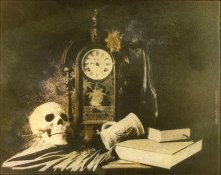Alan_Silvester
Member
I've been set a task to use photography to demonstrate the changing of time. I shoot a lot of long exposure but never really with reference to specifically showing a shift in time, more just using the technique to bring out hidden elements etc. I'll be shooting on digital for this.
My idea is to shoot 3 shots of a clock face across three differing exposures. I know there must be a calculation in here somewhere but can anyone suggest a formula for showing the disappearance of the 3 clock hands across the 3 shots?
If a minute hand rotates across the frame in 60 seconds what exposure duration would just about capture the movement around the clock and still show the blurred hand? What's the limit to the exposure to cause that hand to disappear? The same question for the minute and hour hands...
Alternatively, anyone got a better idea to show the change of time across 3 images? I've been thinking of ice melting, or something with slow movement but it needs to be something with quite a formulaic progression as opposed to an organic change.
Hope that makes sense!
My idea is to shoot 3 shots of a clock face across three differing exposures. I know there must be a calculation in here somewhere but can anyone suggest a formula for showing the disappearance of the 3 clock hands across the 3 shots?
If a minute hand rotates across the frame in 60 seconds what exposure duration would just about capture the movement around the clock and still show the blurred hand? What's the limit to the exposure to cause that hand to disappear? The same question for the minute and hour hands...
Alternatively, anyone got a better idea to show the change of time across 3 images? I've been thinking of ice melting, or something with slow movement but it needs to be something with quite a formulaic progression as opposed to an organic change.
Hope that makes sense!









